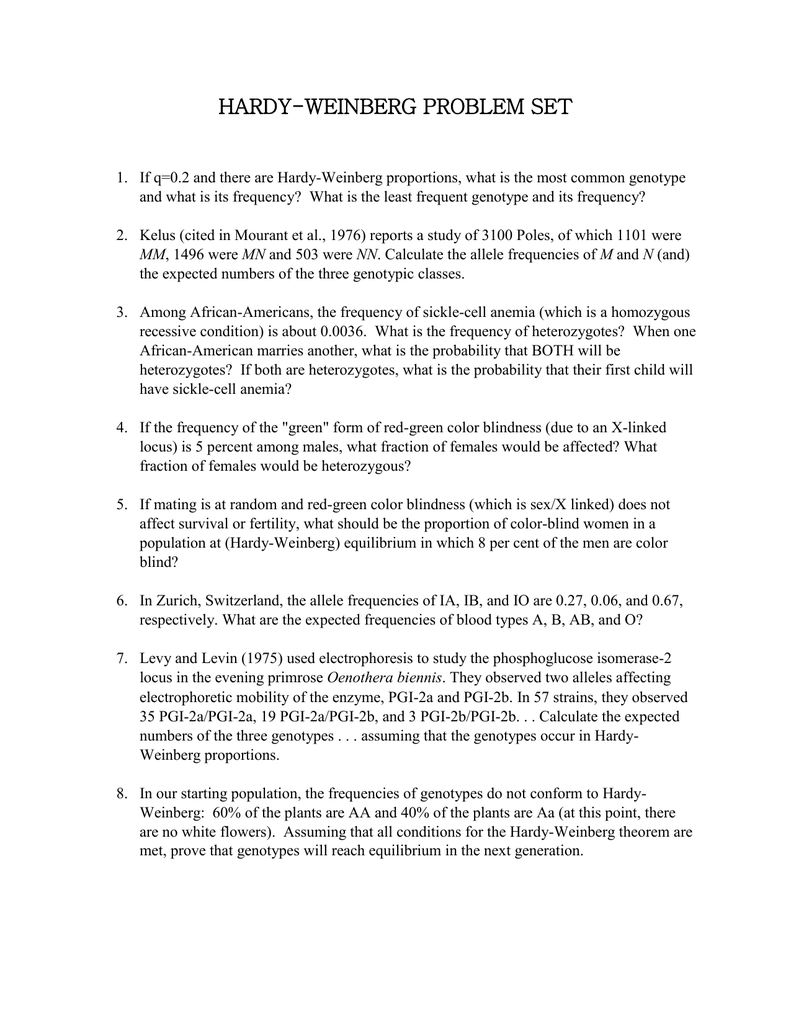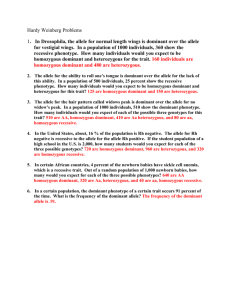Hardy Weinberg Problem Set / Hardy-Weinberg Problem Set ANSWER KEY Name / (a) assuming that mating occurs at random, what are the frequencies of the three genotypes among zygotes produced by this population?
Hardy Weinberg Problem Set / Hardy-Weinberg Problem Set ANSWER KEY Name / (a) assuming that mating occurs at random, what are the frequencies of the three genotypes among zygotes produced by this population?. Speaking of nerds, please forgive the annoying sound buzzes and glitches. What assumption(s) did you make to solve this problem? These frequencies will also remain constant for future generations. Some basics and approaches to solving problems. Coloration in this species had been previously shown to.
Coloration in this species had been previously shown to. (a) assuming that mating occurs at random, what are the frequencies of the three genotypes among zygotes produced by this population? These frequencies will also remain constant for future generations. What are the expected frequencies of the three genotypes in this population? This is a classic data set on wing coloration in the scarlet tiger moth (panaxia dominula).

However, for individuals who are unfamiliar with algebra, it takes some practice working problems before you get the hang of it.
P added to q always equals one (100%). Coloration in this species had been previously shown to. Start studying hardy weinberg problem set. Use the hardy weinberg equation to determine the allele frequences of traits in a dragon population. Follow up with other practice problems using human hardy weinberg problem set. Learn vocabulary, terms and more with flashcards, games and other study tools. The horizontal axis shows the two allele frequencies p and q and the focus of hardy's and weinberg's works was on very small changes at a gene level either due to chance everything is set equal to 1 because all individuals in a population equals 100 percent. I know that this is 0.2 for the s allele (q in the hardy weinberg equation) and 0.8 for the a allele (p in the hardy weinberg equation). A population of ladybird beetles from north carolina a. P2 + 2pq + q2 = 1 p + q = 1 p = frequency of the dominant allele in the population q = frequency of the recessive. P2+2pq+q2 = 1, where 'p' and 'q' represent the frequencies of alleles. Answer key hardy weinberg problem set p2 + 2pq + q2 = 1 and p + q = 1 p = frequency of the dominant allele in the population q = frequency of the recessive allele in the 2pq = 2(.98)(.02) =.04 7. All individuals have equal rates of survival and equal reproductive success.
Use the hardy weinberg equation to determine the allele frequences of traits in a dragon population. Below is a data set on wing coloration in the scarlet tiger moth (panaxia dominula). If given frequency of dominant phenotype. All individuals have equal rates of survival and equal reproductive success. Use the hardy weinberg equation to determine the allele frequences of traits in a dragon population.

(a) assuming that mating occurs at random, what are the frequencies of the three genotypes among zygotes produced by this population?
The law predicts how gene frequencies will be transmitted from generation to generation given a specific set of assumptions. Equilibrium problems the frequency of two alleles in gene pool is 0.19 and 0.81(a). However, for individuals who are unfamiliar with algebra, it takes some practice working problems before you get the hang of it. Some basics and approaches to solving problems. No new alleles are created or converted from existing. The principle behind it is that, in a population where certain conditions are met (see below), the frequency of the. The horizontal axis shows the two allele frequencies p and q and the focus of hardy's and weinberg's works was on very small changes at a gene level either due to chance everything is set equal to 1 because all individuals in a population equals 100 percent. Assume that the population is in equilibrium. Use the hardy weinberg equation to determine the allele frequences of traits in a dragon population. These frequencies will also remain constant for future generations. This is a classic data set on wing coloration in the scarlet tiger moth (panaxia dominula). Speaking of nerds, please forgive the annoying sound buzzes and glitches. Some or all of these types of forces all act on living populations at various times and evolution at some level occurs in all living organisms.
All individuals have equal rates of survival and equal reproductive success. No new alleles are created or converted from existing. However, for individuals who are unfamiliar with algebra, it takes some practice working problems before you get the hang of it. P added to q always equals one (100%). If given frequency of dominant phenotype.

P2 + 2pq + q2 = 1 p + q = 1 p = frequency of the dominant allele in the population q = frequency of the recessive.
All individuals have equal rates of survival and equal reproductive success. Follow up with other practice problems using human genetics and take a survery of ptc tasters to determine the number of heterozygotes in a local. This is a classic data set on wing coloration in the scarlet tiger moth (panaxia dominula). Below is a data set on wing coloration in the scarlet tiger moth (panaxia dominula). However, for individuals who are unfamiliar with algebra, it takes some practice working problems before you get the hang of it. Use the hardy weinberg equation to determine the allele frequences of traits in a dragon population. P2 + 2pq + q2 = 1 p + q = 1 p = frequency of the dominant allele in the population q = frequency of the recessive. What is the frequency of heterozygotes aa in a randomly mating population in which the frequency of all dominant phenotypes is 0.19? Some or all of these types of forces all act on living populations at various times and evolution at some level occurs in all living organisms. What assumption(s) did you make to solve this problem? P2+2pq+q2 = 1, where 'p' and 'q' represent the frequencies of alleles. No new alleles are created or converted from existing. Assume that the population is in equilibrium.

Komentar
Posting Komentar